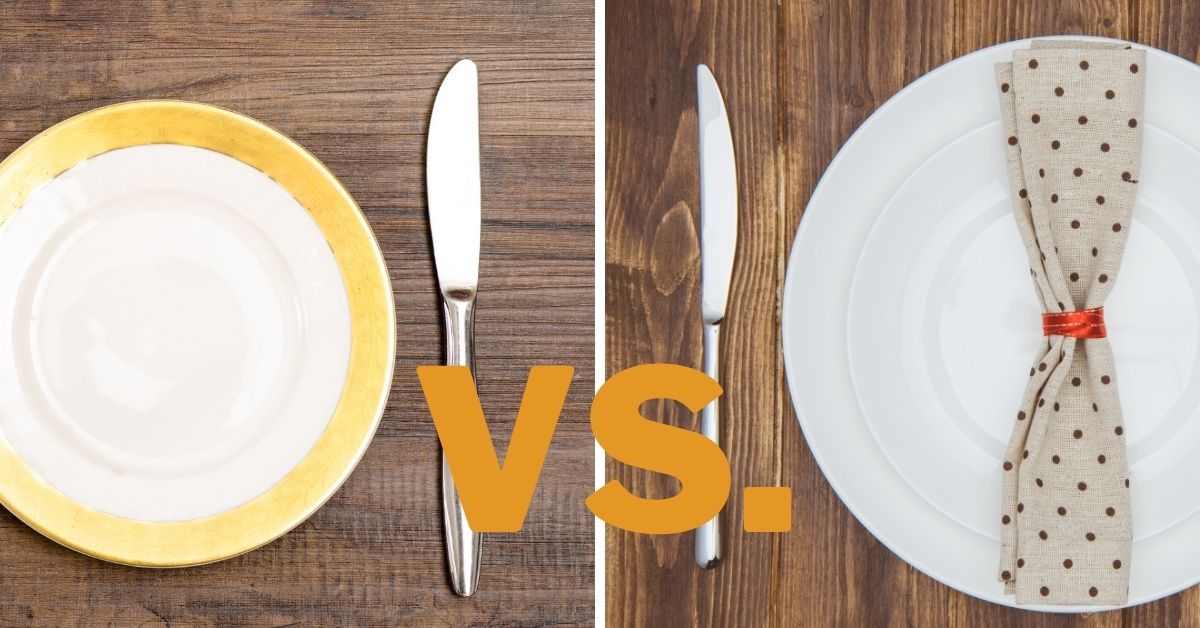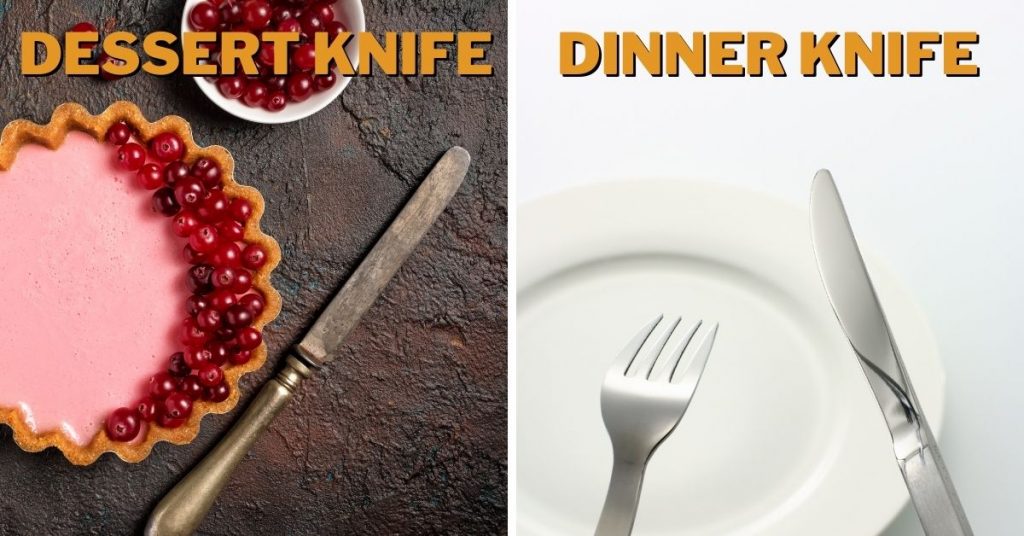Dessert Knife vs. Dinner Knife: Differences

A knife is inarguably the most used cutlery in the kitchen and every chef’s best friend. Using the right knife for the right job will help you make perfect cuts and prevent injuries that occur when you use the wrong knife for specific tasks. So, what is the difference between dessert knife and dinner knife?
A dessert knife is a long, narrow blade with a rounded or pointed tip used to cut desserts and fruits. In contrast, a dinner knife is an everyday, slightly serrated, sharpened knife with a pointy edge used for slicing steak, chicken, veggies, or other foods at dinner or lunch.
Having some basic knowledge of the different parts and construction of a knife will help you choose a good quality knife for various tasks. In this article, I will be looking at the differences between a dessert knife and a dinner knife in detail and a few other commonly used knives.
What Is a Dessert Knife?
As the name suggests, a dessert knife is used to cut the desserts and other soft foods. It is approximately 8 inches long, and that is more, this knife is a specialized piece not made as part of a flatware set.
You can use a dessert knife with a dessert fork or dessert spoon in formal and informal dinners.
How Do You Use a Dessert Knife?
There are two dessert knives, one with a pointed tip and one with a round tip. The one with the pointed tip is used to cut the hard desserts, and a rounded end is to section soft desserts.
You can use a dessert knife with a dessert fork or spoon in formal and informal dinners.
What Is a Dinner Knife Used For?
A dinner knife, also known as a table knife, is all-purpose.
It is used to cut the various foods served as the main dish. Since it is sharp and slightly serrated, it can cut meat, fish, fried food, etc.
In addition, you will find a dinner knife in most flatware place settings.
What Is The Difference Between a Dessert Knife and a Table Knife?
While a dessert knife may look similar to a table knife (aka dinner knife) from a distance, the two knives are very different in structure and function. The following are some of the key differences between a dessert knife and a table knife.
Dessert knives are shorter, measuring approximately 8 inches long, while table knives come in two sizes: place size, which measures around 9¼ inches long, and continental size, which is about 9¾ inches long.
The table knife has a slightly serrated blade and a blunt or rounded end. In comparison, the dessert knife features a narrow blade and can either have a rounded or pointed tip. The rounded tip is used to section soft desserts, and the pointed one is for cutting hard desserts.
As you can guess, the table knife is sharper than the dessert knife.
The table knife is part of a table setting, while a dessert knife is a special knife that is not part of a flatware set. This is why you will easily find the dinner knife at any house, while the dessert knife is not that common.

How to Choose the Right Knife?
It doesn’t matter whether you are a professional cook or just someone who loves to cook for your family; choosing the right knife for particular tasks is of utter importance. Some key things you need to consider when going to buy a knife include;
- Quality
- Price
- Functionality
- Maintenance
- Comfort
Always buy the best quality knife your money can buy, as they are efficient and will make your chopping and cutting more effortless, and they will serve you for a long time.
Here are some tips to help you buy the exact kind of knife you need as you buy a knife.
Tips for Choosing the Right Knife
Buy single knives as opposed to sets. This way, you are sure you will buy the exact knife you need. Should you decide to buy in sets, carefully check what knives are in the set to ensure you don’t end up with knives you’ll never use.
Ensure you understand the features of the knives you are buying with the task you need it to perform in mind.
Consider the type of blade and blade edge the knife has, as this will determine the care and maintenance involved. Some blades require more regular sharpening, and in some cases, you might need to get them sharpened professionally because of the type of blade edge they have.
Ensure that your first set of knives has a chef’s knife, paring knife, utility knife, and bread knife. These knives are versatile and will help tackle almost all of the everyday cutting tasks in the kitchen.
Try out the knife before purchasing. Ensure it feels comfortable and balanced in your hand. You will require less effort when cutting and chopping with a weighted knife instead of a light one.
Knife Care and Maintenance
Whether you are a home cook with just a handful of knives or a restaurant chef dealing with all sorts of knives in there every day, you need to care for and maintain your knives properly. This ensures they serve you efficiently and cut down on kitchen injuries.
Here are some knife care dos and don’ts to help ensure your knives are always in tip-top shape.
Do keep your knife sharp
The most important thing you can do for your kitchen knives is to keep them sharp. A dull knife will reduce your efficiency in the kitchen. You also need to apply more pressure when using it, making the knife more likely to slip and cut you.
Use a whetstone to sharpen your knife at home or get it sharpened by a professional in a cutlery store. Do this once or twice a year.
Do Hone Your Knife
While sharpening involves grinding away small amounts of metal to reshape the knife’s edge, honing aligns the edge of the knife by uncurling and re-straightening the edge of the knife that tends to fold itself after use.
Honing is simple, and you can do it yourself at home. Run your knife a few times against honing steel or rod to realign the edge of your knife. Always hone your blade every time before use.
Don’t Clean in the Dishwasher
Always clean and dry your knife right after use, but never put it in the dishwasher. Putting it in the dishwasher with all those forks and spoons rubbing against it could dull your blade. The chemicals in your dishwashing liquid could cause discoloration to the knife.
Use soap and hot water or only hot water to clean your knife. In case of stains, rub lemon on the stains till they clear, and then rinse off the blade at once.
Do Choose Your Surfaces Wisely
Choosing the suitable surface to do your cutting is vital in maintaining the sharpness of your knife, keeping it durable, and making your chopping and cutting tasks more manageable. Please don’t pick a cutting board with a harder material than the knife itself. Surfaces such as ceramic, glass, marble, and slate will harm your blade.
A wood cutting board or a plastic one will do great! Plus, they are cheap, so why expose your knife to harmful surfaces?
Don’t Store Your Knives With Other Cutlery
How you choose to store your knives is crucial. Always ensure it doesn’t contact surfaces that may dull them. Don’t just toss your nice knives recklessly in a drawer where they’ll bump into and harm each other.
Keep your knives come in a protective block if they come with one, or use magnetic strips, which are protective of the blades, look good, and save kitchen space.
